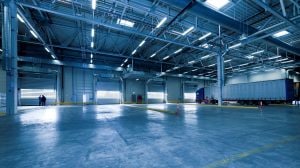June 9, 2021
How to Light a Warehouse
In the past, many warehouse facility managers didn’t give much thought to their space’s lighting unless something went wrong or needed to be replaced. All of that has changed. With energy costs steadily trending upward, advancements in LED lighting optics, and the rise of the “internet of things” (IoT), more decision-makers are recognizing the central role that lighting plays in the logistics business—and the need for a well-thought-out warehouse lighting strategy.
Now that the COVID-19 pandemic and unprecedented eCommerce growth have seen demand for warehouse space at an all-time high, facility managers have an opportunity to think proactively about their warehouse lighting and how to get the most out of renovation or new construction projects. These are the key considerations.
First thing’s first: it’s time to upgrade your warehouse lighting to LED.
If your warehouse is still using traditional fluorescent or HID lighting, you’re likely dealing with regular maintenance tasks and interruptions that are now obsolete, thanks to LED technology. Imagine not having to bring out the scissor lift to troubleshoot or replace a light fixture for ten or more years!
That’s just scratching the surface of how switching to LED lighting improves day-to-day warehouse operations. It’s an upgrade that pays for itself in energy savings and saves you from hassle (and hazards).
Warehouse lighting for savings
- Switch to LED to save up to 70%
- Look for energy rebates or tax incentives
- Consider incorporating sensors for more savings
Simply put: outdated lighting wastes money. Switching to LED in your warehouse can save you up to 70% in energy costs, and typically pays for itself in less than two years. That number doesn’t even take into account potential rebates or tax benefits you could stand to gain.
You can save even more by adding sensors to ensure the lights are only turned on when needed in spaces like break rooms, offices, or restrooms. Occupancy sensing and daylight sensing are two of the most common techniques to maximize LED lighting savings.
Warehouse lighting for safety
- Aim for 10-30 lumens per square foot of space, depending on work being performed
- Choose high bay fixtures with at least 70 CRI (color rendering index)
Your employees are safer when they can see better, and better lighting is a surefire way to keep workplace injuries to a minimum. To determine how much light is sufficient, you’ll want to look at lumens (not watts). You’ll want to provide 10 to 30 lumens per square foot of warehouse space, depending on the work being performed (for example, handling smaller items would require a higher lumen output).
The other number to look at in terms of safety is the color rendering index (CRI); this denotes the accuracy of the light, or how closely it resembles natural sunlight. For industrial spaces, experts recommend lighting with a CRI of at least 70.
Warehouse lighting for productivity
- High-quality LED lighting helps reduce picking errors
- LED can also improve comfort and wellbeing with more natural light and cooler operating temperatures
Experts have long agreed on the connection between high-quality lighting and productivity in virtually every type of space. In warehouses, the right lighting can not only help workers stay alert and focused but can help reduce picking errors that harm your facility’s overall productivity.
Switching to LED helps improve the comfort level within warehouses by not only providing higher-quality (and less headache-inducing) light than traditional HID or fluorescent. LED emissions are up to 40 degrees cooler, helping to keep the facility at a more comfortable temperature during warmer months.
Warehouse lighting for extreme environments
- For optimal performance in refrigerated areas, choose fixtures that are specifically rated and tested for cold environments
- Vaportite fixtures can withstand extreme conditions and pressure washing
In places with cold storage or extreme conditions (like dust, fumes, moisture, or high temperatures), you’ll need to look for warehouse lighting that’s more rugged. You’ll often see this referred to as “vaportite,” and many fixtures carry special certifications. These are fixtures tested and proven to withstand and perform under harsh conditions, and even pressure washing.
Warehouse lighting for people and asset tracking
Real-time location services (RTLS) technology allows you to track products, equipment, and people in your facility, saving time and money and boosting security
In the logistics industry, automation is on everyone’s mind as facility managers look for ways to make everything more efficient. In warehouses, one of the easiest automation “wins” is real-time location services (RTLS) technology to track assets like equipment, products, and even people. Think of it as an indoor GPS system that’ll allow you to get back countless hours spent looking for missing items. It will help keep your facility more secure, too.

